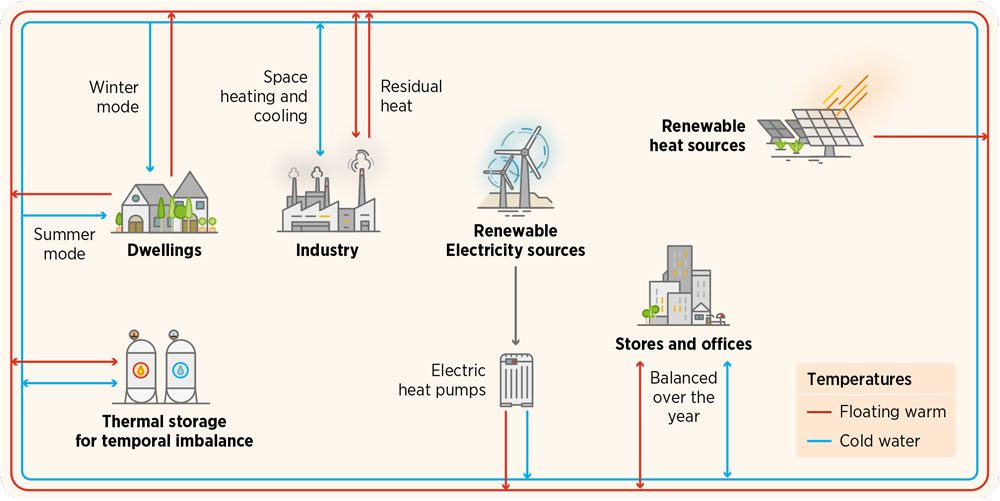Fifth-generation DHC systems
Overview of the status and impact of the innovation

What
Fifth-generation district heating systems distribute heat at even lower temperatures than 4GDH systems. This requires end users to boost temperatures using additional distributed heat pumps (Lund et al., 2021). Users can thus function as customers (by extracting heat from the network) or generators (by injecting heat into the network). The same principle applies for cooling.
5GDH, which is also known as a neutral loop, should not be seen as a sequential generational advancement over 4GDH, but as a variation of 4GDH or “sibling” (Lund et al., 2021). 5GDH is especially suitable for applications where cooling and heating demands are of similar size, making it an important innovation as the global cooling demand rises. 12 5GDH, which is also known as a neutral loop, should not be seen as a sequential generational advancement over 4GDH, but as a variation of 4GDH or “sibling” (Lund et al., 2021).
Fifth-generation systems use bi-directional pipes and a modern control and communications infrastructure (Figure 6.7) to allow users to consume or generate heat, or exchange it among themselves (E.ON, 2022; Kensa Heat Pumps, 2022). Meanwhile, the use of distributed heat pumps allows lower temperatures on the network, thereby reducing transmission heat losses and radically lowering the costs of installing distribution circuits.
FIGURE 6.7 Illustration of a fifth-generation DHC system

Why
Fifth-generation systems can offer benefits beyond fourth-generation systems especially when the levels of heating and cooling demands are similar. They boost efficiency, encourage greater use of renewable sources and can lower overall costs.
BOX 6.9 Fifth-generation district heating and cooling system in the Netherlands
The Mijnwater district heating and cooling system in Heerlen, the Netherlands, used to be a local district heating and cooling network using a flooded coal mine as a low-temperature geothermal source. However, it is a modern urban fifth-generation district heating and cooling system now. The upgraded system uses a backbone of bidirectional pipes to exchange heating and cooling among a data centre, supermarket refrigerators, small-scale industrial processes and connected buildings. It currently serves a building floor area of over 200 000 square metres. New users can easily connect to the bi-directional pipeline with basement heat exchangers, making it easy to expand the system.
By maximising the use of waste heat and renewable energy sources, the upgraded system has cut energy use by 30% compared with the conventional supply system. Other similar pilot projects are being developed in Paris- Saclay (France), Bochum (Germany), Heerlen and Brunssum (the Netherlands), and Glasgow and Nottingham (United Kingdom) (Boesten et al., 2019; Brummer and Bongers, 2019; Bonger and Marini, 2020).
Related kits
Power to heat and cooling innovations
Innovations (35)
-
Technology and infrastructure
- 1 Low-temperature heat pumps
- 2 Hybrid heat pumps
- 3 High-temperature heat pumps
- 4 Waste heat-to-power technologies
- 5 High-temperature electricity-based applications for industry
- 6 Low-temperature thermal energy storage
- 7 Medium- and high-temperature thermal energy storage
- 8 Fourth-generation DHC systems
- 9 Fifth-generation DHC systems
- 10 Internet of Things for smart electrification
- 11 Artificial intelligence for forecasting heating and cooling demands
- 12 Blockchain for enabling transactions
- 13 Digitalisation as a flexibility enabler
-
Market design and regulation
- 14 Dynamic tariffs
- 15 Flexible power purchase agreement
- 16 Flexible power purchase agreement
- 17 Standards and certification for improved predictability of heat pump operation
- 18 Energy efficiency programmes for buildings and industry
- 19 Building codes for power-to-heat solutions
- 20 Streamlining permitting procedures for thermal infrastructure
-
System planning and operation
-
Business models
- 28 Aggregators
- 29 Distributed energy resources for heating and cooling demands
- 30 Heating and cooling as a service
- 31 Waste heat recovery from data centres
- 32 Eco-industrial parks and waste heat recovery from industrial processes
- 33 Circular energy flows in cities – booster heat pumps
- 34 Community-owned district heating and cooling
- 35 Community-owned power-to-heat assets